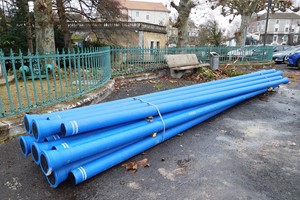Last summer, Joshua Perkins was taken aback to find utility trucks stationed outside his residence, courtesy of Memphis Light, Gas and Water. His puzzlement escalated when, attempting to draw water from his faucet, he found it dry. Concurrently, construction noises reverberated from the street, coinciding with notifications on his phone.
President of his local neighborhood association, Perkins discovered the nature of the activity through a group chat: the utility had initiated a project to replace certain lead pipes in the vicinity. Remarkably, Perkins claimed never to have received any notification letters to this effect. Despite a purportedly "safe" water test from the company three years prior, the recent flurry of activity revived his apprehensions concerning lead contamination.
Perkins voiced his dismay, stating, "No one tells you what they are doing. They just do it." Even subsequent to utility workers excavating pipes from beneath the street outside Perkins's residence, leaving an unfilled sidewalk aperture for months, the lead pipes beneath his abode endured.
A decade after the Flint, Michigan crisis instigated nationwide alarm regarding lead in U.S. drinking water, the White House approximates that over 9 million lead pipelines still furnish homes across the nation. In his inaugural year in office, President Biden secured $15 billion through the bipartisan infrastructure law to confront this issue. Nevertheless, residents nationwide contend with an inconsistent framework for pipeline replacement, engendering bewilderment and uncertainty regarding the safety of their daily tap water.
The ramifications of consuming contaminated water can extend across decades. According to the Centers for Disease Control and Prevention (CDC), there exists no safe threshold for lead exposure, which can induce developmental delays, learning difficulties, and behavioral issues. Even minimal exposure can inflict enduring cognitive impairments, particularly in young individuals, disproportionately affecting Black and economically disadvantaged families. Recent research unveils significant and lasting academic setbacks among school-age children affected by the Flint crisis.
In 2014, Flint officials altered the city's water source to economize, neglecting to ensure the incorporation of corrosion-control chemicals in the new supply. Subsequently, residents in the predominantly Black city, where approximately a third of the populace resides in poverty, promptly registered complaints regarding tainted tap water. Nonetheless, these grievances went unheeded for over a year, resulting in nearly 100,000 Flint residents being exposed to lead through their domestic water sources, as per CDC data.
Following a landmark citizen lawsuit against the city of Flint and Michigan state officials, an accord was reached to finance the removal of all lead service line pipes within the city. Despite the initial commitment to replace all pipes by early 2020, certain residents are still awaiting resolution.
The Environmental Protection Agency (EPA) forecasts that the replacement of nearly 10 million lead pipes furnishing U.S. homes with drinking water could incur a cost exceeding $45 billion. Independently, the EPA has proposed a mandate necessitating water utilities nationwide to replace all such lead pipes within a decade.
"Communities around the country are already engaged in efforts to replace their lead service lines, and some are ahead of others, for sure," remarked Bruno Pigott, the EPA's acting assistant administrator for water.
Since 2022, Tennessee has been allocated approximately $139 million from the infrastructure law to address lead pipe concerns. However, subsequent to fund allocation, it falls upon the state to determine the allocation and disbursement of funds to municipalities.
To qualify for the funding, Memphis's utility must satisfy specific prerequisites, according to LaTricea Adams from the White House Environmental Justice Advisory Council, including the completion of a comprehensive inventory of lead pipe locations. However, as of present, the city awaits approval. Documents provided to the city council indicate that Memphis Light, Gas and Water have executed 5,843 partial replacements since 2012, out of 24,000 lead pipes reportedly present within the city.
Doug McGowen, the utility's president, asserted during a Memphis City Council committee meeting that the complete replacement of all city pipes could amount to as much as $100 million.
Utility spokeswoman Ursula Madden divulged that the company has conducted 4,014 water samples at customers' behest, with 24 samples (0.5%) surpassing the 15 parts per billion threshold at which the EPA recommends lead pipe replacement.
According to data compiled by the Environmental Defense Fund, over 200 water utilities nationwide have established lead service line replacement initiatives, encompassing both partial and full replacement schemes.
Kym Byrd, now benefiting from copper pipes leading to her residence, has contended with the repercussions of lead in Memphis for over two decades.
Initially oblivious to the implications, Byrd became cognizant when housing projects in which she resided initiated testing residents' children for lead in 2002, revealing her son's affliction with lead poisoning. Her son, LaKendrick Young, encountered speech delays and remained mute for prolonged periods until the age of 8, resorting to gesturing instead.
Byrd, initially uninformed of lead pipe replacement programs in Memphis, subsequently deemed them inadequate, likening them to "a Band-Aid on a gash." Concerns are raised by experts that partial replacements might exacerbate lead contamination in the water supply.
Erik Olson, Senior Strategic Director for Health and Food at the Natural Resources Defense Council, emphasized the continued release of lead particles following partial replacements. Additionally, Chet Kibble Sr., an activist and founder of the Memphis and Shelby County Lead Safe Collaborative, cautioned against potential spikes in lead levels post-disturbance of pipes subsequent to replacement.
The EPA, cognizant of the limitations of partial replacements, has advocated for prioritizing full replacement initiatives. While select locales have achieved full lead service line replacement at zero cost to homeowners, the feasibility of replicating such endeavors elsewhere remains uncertain.
In Providence, R.I., partial replacements preceded full lead line replacements subsequent to securing federal funding, a transition that has posed challenges for some residents.
Neyda DeJesus, a Providence resident, discovered her neighborhood's lead pipe replacement initiative via a community meeting, subsequently confirming lead seepage into her drinking water through testing. Expressing bewilderment at the utility's lack of notification, DeJesus plans to resort to filtered water until her pipes are replaced.
Similarly, inconsistent communication regarding ongoing replacement projects plagues Memphis residents. While some, like Andrew Hogenboom, received prior notification, others, like Perkins, were caught unawares. In an effort to bridge this gap, activists and volunteers disseminate information in affected communities.
Sharon Hyde, a Memphis housing program manager for the Green and Healthy Homes Initiative, deems the utility's messaging insufficient in ensuring resident safety.
Margaret Gatewood, a North Memphis resident, grapples with uncertainty regarding her home's pipe composition, apprehensive about potential health implications and the financial burden of replacement. Lamenting her predicament, Gatewood underscores the plight of economically disadvantaged individuals constrained by financial constraints.
For individuals like Gatewood and many others, the pervasive lead pipe issue underscores broader systemic challenges requiring urgent redressal to safeguard public health and ensure equitable access to safe drinking water.
By Amudalat Ajasa












